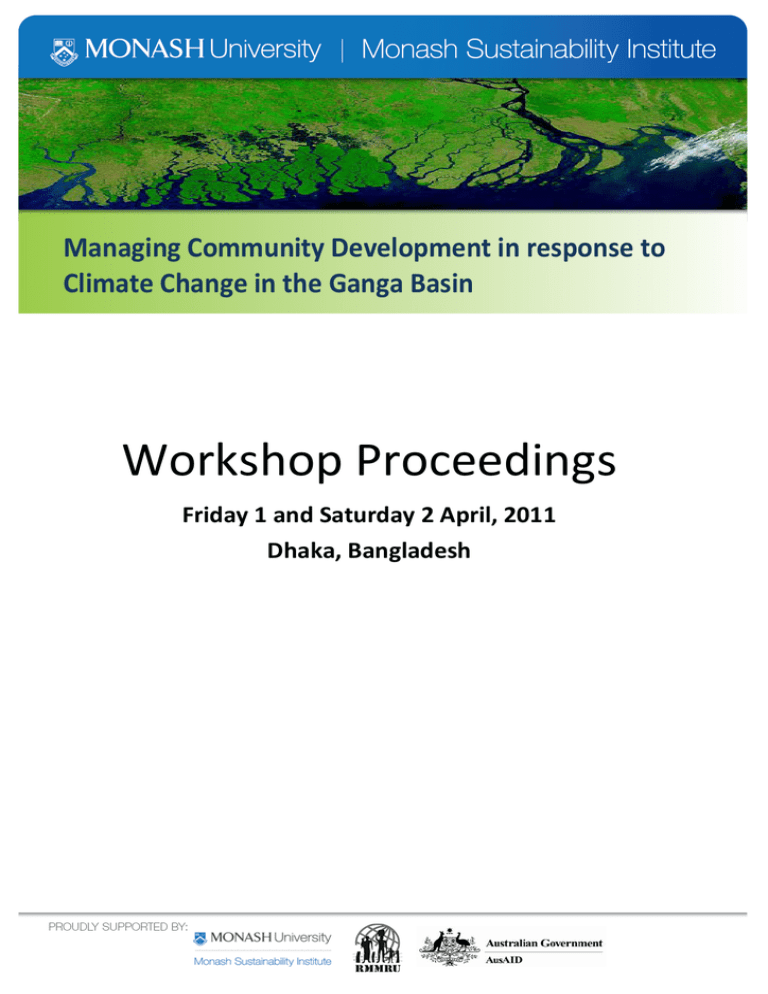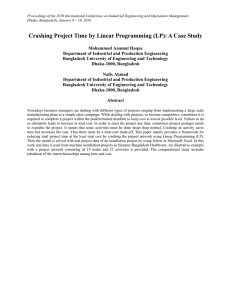Workshop Proceedings Managing Community Development in response to
advertisement

Managing Community Development in response to Climate Change in the Ganga Basin Workshop Proceedings Friday 1 and Saturday 2 April, 2011 Dhaka, Bangladesh Introduction The workshop was part of a Public Sector Linkage Program (AusAID) involving public sector agencies from India and Bangladesh. Participants included senior researchers and policy makers from these countries. Perspectives were also offered by scholars from other countries, including Australia. Opening remarks in relation to the four themes of the workshop were offered by distinguished public servants including: o Dr M. A. Quassem, Chairman National Disaster Management Committee, Bangladesh o His Excellency Dr Justin Lee, Australian High Commissioner to Bangladesh o Dr Ajit Banerjee (rep. the Director), Institute of Development Studies, Kolkata, India o Professor Chowdhury Abrar (representing the host institution), University of Dhaka. o The Chief Guest was Professor Gowher Rizvi (Advisor to the Honourable Prime Minister of Bangladesh) The distinguished guests emphasised the extreme vulnerability of Bangladesh to climate change impacts. As a city, Dhaka is expected to grow to a population of more than 20 million by 2020. This, and the continued exposure to droughts and floods, together with increased frequency and severity of cyclones and sea level rise pose extreme threats. At the same time, Bangladesh wishes to grow its economy, to reduce poverty and to secure gainful opportunities for its people. Many in its rural regions are desperately poor. Public health and sanitation are unresolved issues, both in rural, and increasingly in urban settlements. Migration from rural to urban settings place further pressure on resources (including water during droughts). Two major rivers flow through Bangladesh: the Ganges and the Brahmaputra. The deltas of these rivers present productive opportunities for agriculture and support wetlands of international significance (the Sunderbans). The Sunderbans are threatened by saline intrusion, by extreme climatic events, and by unsustainable development. The workshop addressed four themes: o Inter-agency collaboration and co-ordination for improved water resource allocation o Managing rural communities in response to urbanisation o Groundwater and rural health issues o Food and water security in response to climate change Page 2 Summary of Presentations Dr Paul McShane Monash Sustainability Institute, Monash University, Victoria, Australia Knowledge Management for Improved Agency response to Climate Change Rivers which cross state boundaries require a co-ordinated response by agencies for sustainable water resource allocation. This is particularly important as climate change and population growth will reduce water availability. Knowledge management is the systemic integration of knowledge including both formal (e.g. science) and informal (e.g. traditional lore) to inform policy. It includes structural elements (including mechanisms for sharing information among organisations) and functional elements (including collection and analysis of information). Examples of structural elements including organisational behaviour and information communication technology. Examples of functional elements include river basin models and evaluation of climate change impacts. The linking of bio-physical (e.g. hydrological) and socio-economic (e.g. agriculture production) models provides a basis for the evaluation of alternative policy options and for coordinating the activities of river management agencies across state boundaries. Ms Fiona Chandler International WaterCentre, Brisbane, Australia The Role of the Community in Determining Changes in River Health Human activities and climatic events in river basins threaten water resource security and ecosystem health. Environmental values, which are qualities of water and rivers aquatic ecosystems and human water uses, can be used to set management objectives. Examples of this approach from the Yellow River, China, demonstrate the link between ecological river health and social river health (e.g. economy). Report cards which evaluate performance of river basin management against ecosystem health and social health values can provide a comparative context for examination of river basin status. This is of value in bringing management issues to the attention of policy makers and to the community at large. Dr Jenia Mukherjee Institute of Development Studies, Kolkata, India “Big” Conservationist Approach vs. Popular Science: Exploring the Dynamics of Wetland Ecosystem in the peri-urban interface of Calcutta The wetlands of east Calcutta play an important role in water resource management. The wetlands are used to treat the city’s waste water with the treated water is then used for aquaculture and agriculture. Urbanisation is threatening the viability and functionality of the wetlands. Knowledge based on traditional practices provides a cost effective approach to waste water management in a major urban setting. Interventions which protect wetlands provide economic and social benefits and these interventions should inform urban planning. Page 3 Professor Joyashree Roy Jadavpur University, Kolkata, India Estimating Welfare Impact of Arsenic in Ground Water of West Bengal Arsenic contamination of tube wells in West Bengal is widespread and presents serious health issues to those dependent on ground water for drinking. Action to purify drinking water will result in improved health benefits which can be measured economically through increased productivity. Low income households are particularly vulnerable and poverty reduction strategies must include water quality remediation. Professor Joyashree Roy Jadavpur University, Kolkata, India Coping with Climate Variability in River Basins and Policy Implications Climate issues are intrinsically related to wider developmental issues. Droughts, floods, and other extreme weather events affect productivity, particularly those rural communities which are dependent on agriculture for their livelihoods. Policy frameworks which address livelihoods (employment), institutional rules (social cohesion), food (poverty) and empowerment (education and health) are an important response to climate change. Coping capacity will reflect responsiveness to these issues. Case study analyses from Indian river basins show that local, state, and national responses are needed. These responses include improved information dissemination (education programs), improved water resource management, and regional water sharing agreements. Professor Marika Vicziany Monash Asia Institute, Monash University, Victoria, Australia Food Security and Climate Change Food wastage has been underrepresented in discussions of food security issues in India. As food storage increases, rat populations also increase, with concomitant impacts on pre and post harvest crops. The decline in natural predators (owls, foxes, and snakes) through agriculture has increased rat populations. Rats can also affect soil structure through burrowing with associated instability of soils and loss of productivity. With climate change, rats and humans will compete more directly as rats can adapt to both droughts and floods. Addressing food wastage through integrated pest management strategies should be included in any response to climate change. Mr Mohammad Harunar Rashid Bhuyan Monash Asia Institute, Monash University, Victoria, Australia The Politics and Economics of Resilience: Peasant Perceptions and Responses to Disaster in the Sunderban Area, Bangladesh Peasants in Bangladesh are highly dependent on agriculture for employment and food security. Floods and cyclones affect peasant communities through lost agriculture production. Peasant perceptions to climate change are an important part of an adaptation response (particularly local knowledge). Page 4 For example, paddy protection from saline intrusion can protect rice crops. Continuous selection of resistant varieties of crop (droughts, floods) can promote resilience of peasant farmers. Continuing studies will assess local knowledge and perceptions to measure resilience and adaptation given likely climate change in Bangladesh. Dr Sandhya Rao INRM Consultants, New Delhi, India Water Resources and Climate Change Changes in precipitation and temperature will influence water resources through affecting the spatial and temporal distribution of flow. Other changes will include snow and glacier melts, evapotranspiration, sedimentation and water quality. These changes are exemplified in the Ganga Basin, a large basin influenced by changes in regional climate. Coupling of ground water and surface water resources is an important consideration when evaluating climate change impacts. However, regional climate models are imprecise and present uncertainties. Moreover, land use changes can also influence climate and water resources. Development of models which incorporate realistic changes to water flow can assist in planning responses to drought and floods. Mr Abu Ala Mahmudul Hasan Anthropologist, Bangladesh Climate Change Adaptation in Bangladesh: Approach and Implementation Cost effective and viable responses to climate change in Bangladesh can include shelter, early warning systems, embankments (to protect against floods), new crop varieties (better adapted to changed climate), and changes to farming techniques. However, implementation of these measures is currently frustrated by poor maintenance (e.g. embankments), corruption among authorities, socio-political issues, and poor planning. The social impact of new technologies is an important consideration when planning for climate adaptation in Bangladesh. Mr Abu Sumon UNDP, Bangladesh Better Options for Integrated Floodplain Management in Changing Climate Scenarios Floodplains in Bangladesh support many and varied livelihoods particularly for rural communities. More than 80 per cent of rural people depend on wetland resources. Improved management of floodplains can deliver economic and social benefits with some 250 to 300 kg/ha of agricultural production. Degradation of habitats arising from reduced flows in major rivers (e.g. the Padma/Ganges) has resulted in lost productivity. Lack of dry season water, lost connections between beels, khals and rivers, sedimentation, pollution and destructive fishing practices are having adverse impacts. Poor land management practices including unsustainable cultivation on hill slopes and loss of riparian vegetation is increasing sediment loads of rivers leading to further degradation of flood plains and fisheries. A basin wide approach is needed to link land and water resource management. Crops which require less irrigation (e.g. wheat, maize, onions, and potatoes) should be favoured over water intensive crops (e.g. Boro rice). Page 5 Dr Ajit Banerjee IDSK, Kolkata, India Likely Livelihood Impact on the Indo-Gangetic Communities due to Global Warming The Ganga Basin can be divided geographically into three sections: the mountain, alluvial and low hill, and the plains and delta. The Ganga Basin drains an area of about 1 million sq km supporting a human population of more than 450 million. Most (70%) people living in the Ganga Basin depend on agriculture (some 160 million ha under cultivation). Poverty and pollution are widespread. Climate change will affect the three sections of the Ganga Basin differently. Saline intrusion in the delta will affect vegetation and fisheries. Adaptation strategies, including building of embankments, will further affect land use and migration away from affected areas will create congestion in urban areas. In the alluvial and hill sections, change in temperature will influence the distribution and abundance of forest species. These changes will also affect the micro climate through changes to evapotranspiration. Changes to temperature and rainfall will also affect agriculture and the types of crops that can be successfully cultivated. Professor Bob Pokrant School of Social Sciences and Asian Languages, Curtin University, Australia Community-based Adaptation to Climate Change in Bangladesh: The View from Below There is a need to incorporate climate change issues into broader planning for exposed regions. The poor and marginal communities are most vulnerable and a local approach should form part of the adaptation response. Participatory learning and action research in which cross-disciplinary teams work with local communities is likely to improve adaptive strategies. Changes to water flow from the Farakka Barrage will affect local livelihoods through changes to rice and shrimp farming. Rice farmers are affected by crop damage, increased salinity, and changes to rainfall patterns. Shrimp farmers are affected by storm damage, dyke failure, sedimentation, high temperatures, and water availability. Poor communities are particularly dependent on the Sunderbans and lower estuary for livelihoods. They are also severely affected by cyclones as demonstrated recently with Cyclone Aila. An ecosystem-based approach for wider area management is needed as an alternative to political boundaries. At village level, adaptive measures to cope with immediate and seasonal water shortages, salinity, flooding, and cyclones are needed rather than potential packages of measures to deal with longer term changes in climate. Dr Brett Parris Faculty of Business and Economics, Monash University, Australia Synopsis of the 5th International Conference on Community-based Adaptation to Climate Change The conference included field trips and meetings attended by more than 300 delegates from around the world. An emphasis was on horizontal replication of community-based adaptation together with vertical multi-scale adaptation (e.g. infrastructure). There was an identified need to focus on synergies including adaptation to climate variability as well as climate change. Many presentations addressed rural communities as they were considered to be most exposed to climate change particularly in developing South Asian countries. Page 6 However, most people live in urban areas and these communities have been underrepresented in discussions on climate change impacts. Effective adaptation responses can be learnt from those countries that have already been exposed to natural disasters (e.g. Cyclone Aila, floods, and droughts). Professor Chowdhury Abrar Director, Refugee and Migratory Movements Research Unit, University of Dhaka, Dhaka, Bangladesh Coping with Riverbank Erosion in Northwest Bangladesh Northwest Bangladesh is among the most economically depressed regions of Bangladesh. Migratory communities which occupy river banks (Chars) are exposed to floods and climate change more generally. Food insecurity, access to safe drinking water and shelter are points of exposure to these communities. Kinship and social networks are influential in choosing where to settle. Cost of living and employment opportunities are also important considerations. Migration is an important livelihood strategy for many. Seasonal migration during sowing and harvest times is prominent with information being transferred through social networks. Impacts of forced displacement (e.g. flooding of chars) includes crop loss (78%), livestock loss (54%) and damage to housing (42%). Other impacts include reduced opportunities for employment, disruption to family cohesiveness and to traditional livelihoods (including religion and education). Women and children are disproportionately affected. Health impacts through water borne diseases and malnutrition are problematic. There is a need to improve sanitation and general hygiene through targeted education programs. Professor Maniruzzamann Miah University of Dhaka, Dhaka, Bangladesh Climate Change, Food and Water Security Changes affecting South Asia include the retreating of glaciers and increased snow melts. Nepal’s mainland rivers contribute 40 per cent of wet season and 70 per cent of dry season flows. Changes to rice production will occur with changes to local rainfall. Early floods will affect dry season crops (Boro) with extended flood peaks affecting wet season crops (Aman). Sharing of water resources among riparian states will become more of an issue with climate change. Water availability to Bangladesh has been adversely affected with the construction of the Farakka barrage on the Ganges River. Strategies to share water can be influenced by government and internal governance issues. Demand management should form part of the sharing arrangements rather than concentrating on supply side issues. Mr Terry Cannon and Professor Saleemul Huq Climate Change and Development Group, International Institute for Environment and Development, United Kingdom Designing Action Research for Support to Community Development and Adaptation to Climate Change Climate dependent populations are widespread in Bangladesh. Barriers to development need to be recognised. Adaptation at grassroots level is required as is appropriately targeted funding. Page 7 Ongoing research at 18 sites in Bangladesh provides an opportunity to evaluate adaptation strategies. Surplus labour can be used to improve agricultural production as can more effective crop planting strategies which take into account likely changes to seasonal temperature and rainfall. Saline tolerant varieties will also be needed in those coastal areas affected by coastal intrusion. Adaptation strategies will need to be politically, socially and culturally realistic given the influence that these factors have on a country-wide response. Professor Tasneem Siddiqui University of Dhaka, Dhaka, Bangladesh Community development issues Bangladesh Migration in Bangladesh is seen as a major threat (e.g. increased population density in major cities) but it is also a legitimate response to climate change and an important livelihood strategy. In 2009, Bangladesh received nearly USD11 billion in remittance revenue equivalent to 56 per cent of total export earnings. Migration from rural communities during floods is an important adaptation response. However, slower migration patterns are emerging in response to drought and to declining land quality. A co-ordinated approach to managing migration in response to climate change will be required if Bangladesh is to improve economic and social well being and to reduce dependence on foreign remittances. Associate Professor Sharif As-Saber RMIT University, Melbourne, Australia Geopolitics of Governance in Ganga and Brahmaputra River Basins: Changing Climate and Shifting Agenda Emerging geopolitical issues associated with major river systems reflect tension in water resource allocation among states. The Brahmaputra and Ganga river basins cross several countries and states and equitable water resource allocation policies require greater co-operation and improved governance than is presently the case. Location specific issues, mainly relating to natural resources (e.g. forests, agriculture) or to infrastructure (e.g. dams) require holistic solutions as they can affect beneficial uses of the river basin (e.g. for downstream riparian states). Demographic, cultural and political issues will be important in the identification and implementation of water resource allocation strategies. Professor Giasuddin Ahmed Choudhury Centre for Environment and Geographical Information Services (CEGIS), Dhaka, Bangladesh Morphological Response of the Ganges River due to Climate Change Historical changes in the course of major rivers has affected communities particularly in Bangladesh. Flood forecasting, including prediction of river bank erosion, can be assisted by satellite imagery which can track changes in river basin morphology. The 1996 treaty with India was important in recognising changes to water availability affected by the Farakka barrage. This has caused hydrological changes to the Ganges downstream of the barrage. Unresolved issues include salinity and its impact on agriculture production in Bangladesh. Risk reduction strategies that reflect likely climate change include the building of cyclone shelters and rising of lands through sedimentation. Page 8








